In this edition:
* SpaceX Delays Crew-8 Astronaut Launch to Make Way for Private Moon Mission
* Upcoming Rideshare Launch to Include Amateur Payloads
* Bill Introduced to Eliminate Private Land Use Restrictions on Amateur Radio
* Small Launch Companies Seek Niches to Compete With SpaceX Rideshare
* Changes to AMSAT-NA TLE Distribution for February 16
* ARISS News
* Upcoming Satellite Operations
* Hamfests, Conventions, Maker Faires, and Other Events
* Satellite Shorts From All Over
The AMSAT News Service bulletins are a free, weekly news and information service of AMSAT, the Radio Amateur Satellite Corporation. ANS publishes news related to Amateur Radio in Space including reports on the activities of a worldwide group of Amateur Radio operators who share an active interest in designing, building, launching and communicating through analog and digital Amateur Radio satellites.
The news feed on http://www.amsat.org publishes news of Amateur Radio in Space as soon as our volunteers can post it.
Please send any amateur satellite news or reports to: ans-editor [at] amsat.org
You can sign up for free e-mail delivery of the AMSAT News Service Bulletins via the ANS List; to join this list see: https://mailman.amsat.org/postorius/lists/ans.amsat.org/
ANS-049 AMSAT News Service Weekly Bulletins
To: All RADIO AMATEURS
From: Radio Amateur Satellite Corporation
712 H Street NE, Suite 1653
Washington, DC 20002
DATE 2024 Feb 18
SpaceX Delays Crew-8 Astronaut Launch to Make Way for Private Moon Mission
NASA’s next astronaut launch will delay nearly a week to let a moon mission leave Earth first.
NASA’s Crew-8 astronauts, who will launch on a SpaceX Crew Dragon, will fly to space no earlier than Feb. 28. The delay from Feb. 22 will make room for the expected launch of Intuitive Machines’ moon lander from the same launch pad at NASA’s Kennedy Space Center in Florida.
Odysseus, a robotic lunar lander built by the Houston-based company Intuitive Machines, lifted off atop a SpaceX Falcon 9 rocket from NASA’s Kennedy Space Center (KSC) in Florida early in the morning on Thursday, Feb. 15.
If all goes according to plan, Odysseus (designated IM-1) will touch down near the moon’s south pole on Feb. 22, becoming the first-ever private spacecraft to ace a lunar landing. Success would also be a big deal for the United States, which hasn’t been to the lunar surface since NASA’s Apollo 17 mission more than half a century ago.
“NASA and SpaceX will continue to assess Crew-8 readiness and may adjust the Crew-8 launch date following a successful IM-1 launch,” agency officials wrote in a statement on Feb. 13, while announcing the delay. The astronaut mission will serve as relief for Crew-7, which flew to space on Aug. 26 for an International Space Station mission expected to last six or seven months.
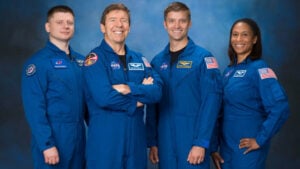
SpaceX Crew-8 crew. From left to right: Roscosmos cosmonaut Alexander Grebenkin, NASA astronaut Michael Barratt, KD5MIJ, NASA astronaut Matthew Dominick, KCØTOR, and NASA astronaut Jeanette Epps, KF5QNU.
Crew-8 includes NASA astronauts Matthew Dominick, KCØTOR (commander), Michael Barratt, KD5MIJ (pilot), and Jeanette Epps, KF5QNU (mission specialist), along with Roscosmos cosmonaut and mission specialist Alexander Grebenkin.
Both the ISS crew and the IM-1 launch are using a pad SpaceX leases at NASA’s Kennedy Space Center. The moon mission has a fairly narrow launch window as the IM-1 lander needs specific landing conditions to land at the lunar south pole, which is part of why the launch date for Crew-8 may be adjusted.
Crew-8, as the name implies, is the eighth crewed operational mission by SpaceX that sends commercial crews to the ISS on NASA’s behalf. Starliner, the second vendor, may fly its first test crew in mid-April 2024.
[ANS thanks Space.com for the above information.]
The 2024 AMSAT President’s Club coins are here now!
Help Support GOLF and Fox Plus
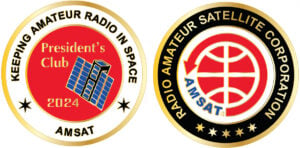
Join the AMSAT President’s Club today and help
Keep Amateur Radio in Space!
https://www.amsat.org/join-the-amsat-presidents-club/
Upcoming Rideshare Launch to Include Amateur Payloads
The SpaceX F9 Transporter-10 Rideshare mission has been scheduled for launch on 1 March 2024. In addition to a half dozen commercial payloads, two amateur satellites are on the launch manifest: SONATE-2 from Germany and CroCube from Croatia.
SONATE-2
SONATE-2 is a 6U+ CubeSat designed and built by the University of Wuerzburg in Germany. As for many university satellites, the mission objectives of the SONATE-2 satellite can be divided into three different parts:
– The operation of an amateur radio payload
– The development and operation of the satellite for the education of students.
– The operation of a novel payload as a technology demonstration in space.
The amateur payload of SONATE-2 consists of a VHF transceiver that was already built for the predecessor mission SONATE over the course of several student theses. For SONATE-2 additional student theses extended the transceiver functionalities. It will provide regular SSTV downlinks with images from the optical sensors included in the AI payload as well as an APRS digipeater and CW beacon.
On the education side, the mission will serve as a foundation for different aspects of the university aerospace and computer science engineering program. In the context of practical courses, theses or as student assistants, students can participate in the development of all subsystems of the space and ground segment, including the amateur radio payload and the technology demonstration payload. In the context of mandatory lectures and exercises on space operations every student will also be included in the operations of the satellite. The German Aerospace Center (DLR) offers a School Lab for high school students at the location of our external ground station in Neustrelitz, Germany.
Besides experiments on space and satellites, the School Lab includes amateur radio contacts to the ISS under the supervision of licensed local radio amateurs, which they wish to extend to other satellites like in this cooperation with the SONATE-2 mission.
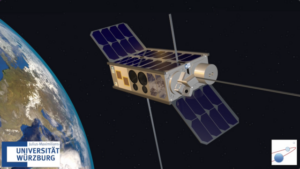
In addition to the amateur and educational mission parts, the SONATE-2 mission also has a research objective for the demonstration of novel artificial intelligence technology in the space environments. While the AI payload is mainly operated using a separate up/downlink in the space operation service in S-band, the satellite bus and the amateur payloads are operated in the amateur service. Housekeeping telemetry in the amateur service also contains status information of the non-amateur payload.
Proposing CW, SSTV using Martin M1 and APRS downlinks on VHF and a 9k6 G3RUH AX25 telemetry downlink on UHF. Planning a launch into a 550 km Sun-Synchronous Orbit (SSO). More info at https://go.uniwue.de/hk. Downlinks on 437.025 MHz, 145.825 MHz, 145.840 MHz and 145.880 MHz have been coordinated by the International Amateur Radio Union (IARU).
CroCube
CroCube is a 1U CubeSat mission to support the Croatian, but also worldwide amateur radio community with many HAM services and activities. The mission’s goal is also to facilitate the technological development of Croatia, create an advanced society focused on prosperity and innovation, and increase participation in the global space sector. Also, drive Croatia into the space era, increase interest in astronomy and space projects, and develop STEM and tech entrepreneurship, create a platform for founding a space center in Croatia, increase investments and employment in robotics, technology and ICT and finally reduce unemployment and prevent brain drain.
The CroCube satellite is designed for HAM radio activities. The main purpose is to provide services for radio amateurs in Croatia and worldwide, and also for students of technical universities to get hands-on experience with satellite communication and get radioamateur licences. One of the project goals is to popularize HAM activities across the common population, students and children in Croatia.
CroCube will provide these HAM services:
– AX.25 telemetry
– CW beacon
– Digipeater
– Anniversary/special occasions AX.25 & CW messages for community engagement
– Experimental SSDV transmissions
– SATNOGS integration, decoder, dashboard
Proposing a UHF downlink using 9k6 G3RUH GFSK with AX25 telemetry. Planning an Exolaunch deployment into a 510 km SSO. More info at https://drustvo-evo.hr . A downlink on 436.775 MHz has been coordinated by IARU.
[ANS thanks Libre Space, Jan van Gils, PE0SAT, and IARU for the above information]
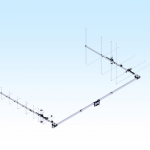
Need new satellite antennas? Purchase M2 LEO-Packs
from the AMSAT Store. When you purchase through
AMSAT, a portion of the proceeds goes towards
Keeping Amateur Radio in Space.
https://amsat.org/product-category/hardware/
Bill Introduced to Eliminate Private Land Use Restrictions on Amateur Radio
U.S. Senators Roger Wicker (MS) and Richard Blumenthal (CT) introduced S.3690 on January 30, 2024, the Senate companion bill to H.R.4006, introduced last June. Both bills reflect the Congressional campaign efforts by ARRL to eliminate homeowner association land use restrictions that prohibit, restrict, or impair the ability of an Amateur Radio Operator to install and operate amateur station antennas on residential properties they own.
Amateur Radio Operators repeatedly are relied upon to provide essential communications when disaster strikes, but their ability to do so is being impaired by the exponential growth of residential private land use restrictions that hinder their ability to establish stations in their homes with which to train and provide emergency communications when called upon.
In announcing the introduction of S.3690, Senator Wicker said: “Because communication during natural disasters is often hindered, we should be making every attempt to give folks more options. Reliable access can make the difference between life and death in an emergency. Our legislation removes roadblocks for amateur radio operators looking to help their friends, families, and neighbors.”
In a similar announcement, Senator Blumenthal stated: “Our measure will help clarify the rules so ham radio enthusiasts can successfully continue their communications.
In the face of emergency or crisis, they help provide vital, life-saving information that allow listeners to properly and safely respond, but prohibitive home association rules and confusing approval processes for installing antennas have been an unnecessary impediment. The Amateur Radio Emergency Preparedness Act resolves these bottlenecks and ensures that radio operators can function successfully.”
ARRL President Rick Roderick, K5UR, and Director John Robert Stratton, N5AUS, Chair of the ARRL’s Government Affairs Committee, both extended on behalf of ARRL, its Members, and the Amateur Radio community their thanks and appreciation for the leadership of Senator Wicker and Senator Blumenthal in their continuing efforts to support and protect the rights of all Amateur Radio Operators.
[ANS thanks ARRL News for the above information]
Small Launch Companies Seek Niches to Compete With SpaceX Rideshare
Small launch vehicle developers are working to carve out niches in a market for smallsat launches that is increasingly dominated by SpaceX’s Transporter rideshare missions.
The Transporter missions, which fill a Falcon 9 often with more than 100 smallsats, offer per-kilogram prices significantly below dedicated small launch vehicles. SpaceX has seen high demand for those missions and announced plans last year for a related line of missions called Bandwagon that will go to mid-inclination orbits.
“The Transporter program was created a few years ago with, in my opinion, the sole purpose of trying to kill new entrants like us,” said Sandy Tirtey, director of global commercial launch services at Rocket Lab, during a panel at the SmallSat Symposium in Mountain View, Calif. on Feb. 7. “Yet, we are still flying because we offer something unique.”
That uniqueness, he argued, is the ability to fly missions to specific orbits not served by Transporter rideshare missions. An example is Rocket Lab’s next Electron launch, which will place into orbit the ADRAS-J inspector satellite for Astroscale. That mission requires a specific, precise orbit so that ADRAS-J can rendezvous with a derelict Japanese upper stage.
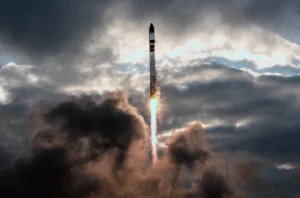
A Rocket Lab Electron launched four smallsats for NorthStar Earth and Space Jan. 31. Credit: Rocket Lab
“Electron is really the only vehicle capable of delivering such a complex mission on an expedited timeline,” Peter Beck, chief executive of Rocket Lab, said in a Feb. 7 statement about the launch, scheduled for Feb. 19 (New Zealand time). Rocket Lab said the specific launch time will be determined just a day before launch, with a near-instantaneous launch window.
“Most of the missions that we fly are enabled by the fact that we offer dedicated services,” Tirtey said, citing the upcoming ADRAS-J launch. “There is no way you could do this on a rideshare.”
Other panelists said they are targeting customers with specific requirements or needs that make them less price-sensitive than those who opt for the less expensive Transporter launches. That includes dedicated orbits and high reliability, said Pablo Gallego, senior vice president of sales and customers at Spanish launch company PLD Space. “We are offering a premium service for the ones that are willing to pay.”
That argument, though, is in danger of being undercut by the combination of rideshare launches and orbital transfer vehicles (OTVs), which can take satellites to their desired orbit after being deployed from a Transporter or similar launch. Several companies are offering such vehicles and using them on Transporter launches.
While that combination may still be less expensive than dedicated launches, it still doesn’t offer sufficient flexibility, launch providers argued. “We are excited to partner with a lot of OTV providers in providing that service to our customers, but it comes down to performance and how quickly you can get there,” said Robert Sproles, chief technology officer of launch services company Exolaunch. “If it takes you multiple months on orbit to get to that final destination, there’s a strong argument to be made to going dedicated.”
Tirtey said that maneuvers that require plane changes can take months to complete, adding that current OTV providers have yet to demonstrate the ability to perform such complex maneuvers. “It could be useful, but you can’t expect a revolution because of physics.”
However, on another panel at the conference Feb. 6, industry officials said they see challenges for small launch vehicles coming from SpaceX’s Starship, which promises much greater performance at significantly lower prices. “If you’re a smallsat company, your business model should be looking forward to the model of the Starship rideshare,” a scaled-up version of Falcon 9 rideshare, said Abhishek Tripathi, director of mission operations at the University of California Berkeley’s Space Sciences Lab and who previously worked at SpaceX.
He said that the introduction of Starship could change how spacecraft are designed, allowing the use of heavier but cheaper materials and components. “You can throw mass and power and volume at your problem and thereby scale up your satellite bus and still be cheap.”
[ANS thanks SpaceNews for the above information]
Want to fly the colors on your own grid expedition?
Get your AMSAT car flag and other neat stuff
from our Zazzle store!
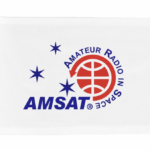
25% of the purchase price of each product goes
towards Keeping Amateur Radio in Space
https://www.zazzle.com/amsat_gear
Changes to AMSAT-NA TLE Distribution for February 16
Two Line Elements or TLEs, often referred to as Keplerian elements or keps in the amateur community, are the inputs to the SGP4 standard mathematical model of spacecraft orbits used by most amateur tracking programs. Weekly updates are completely adequate for most amateur satellites. TLE bulletin files are updated daily in the first hour of the UTC day. New bulletin files will be posted immediately after reliable elements become available for new amateur satellites. More information may be found at https://www.amsat.org/keplerian-elements-resources/.
- Lume-1 NORAD Cat ID 43908 Decayed from orbit on or about 13 February 2024
- FEES NORAD Cat ID 48082 Decayed from orbit on or about 12 February 2024
[ANS thanks AMSAT Orbital Elements page for the above information]
ARISS NEWS
Amateurs and others around the world may listen in on contacts between amateurs operating in schools and allowing students to interact with astronauts and cosmonauts aboard the International Space Station. The downlink frequency on which to listen is 145.800 MHz worldwide.
COMPLETED CONTACTS
School TBD, Naro-Fominsk, Russia, direct via UB3AYC
The ISS callsign was RSØISS
The crewmember was Nikolay Chub
The ARISS mentor was RV3DR
Contact was successful for Thu 2024-02-15 08:22 UTC
Congratulations to the Naro-Fominsk students, Nikolay, and mentor RV3DR!
B. Russell High School, Rome, Italy, direct via IKØUSO
The ISS callsign was OR4ISS
The crewmember was Jasmin Moghbeli KI5WSL
The ARISS mentor was IKØUSO
Contact was successful: Thu 2024-02-15 11:32:10 UTC 54 deg
Congratulations to the B. Russell High School students, Jasmin, and mentor IKØUSO!
Watch for Livestream at https://www.youtube.com/watch?v=R0YEgMvzbn8
Immanuel Kant Baltic Federal University, Kaliningrad, Russia, direct via R2FDB
The ISS callsign was to be RSØISS
The crewmember was Konstantin Borisov
The ARISS mentor was RV3DR
Contact was successful for: Fri 2024-02-16 09:10 UTC
Congratulations to the Immanuel Kant Baltic Federal University students, Konstantin, and mentor RV3DR!
SCHEDULED CONTACTS
Girl Scout Troop 1089, Sacramento, CA, direct via N6NA
The ISS callsign is presently scheduled to be NA1SS
The scheduled crewmember is Loral O’Hara KI5TOM
The ARISS mentor is AA4KN
Contact is go for: Thu 2024-02-22 18:26:02 UTC 89 deg
The crossband repeater continues to be active (145.990 MHz up {PL 67} & 437.800 MHz down). If any crewmember is so inclined, all they have to do is pick up the microphone, raise the volume up, and talk on the crossband repeater. So give a listen, you just never know.
The packet system is also active (145.825 MHz up & down).
As always, if there is an EVA, a docking, or an undocking; the ARISS radios are turned off as part of the safety protocol.
Note, all times are approximate. It is recommended that you do your own orbital prediction or start listening about 10 minutes before the listed time.
The latest information on the operation mode can be found at https://www.ariss.org/current-status-of-iss-stations.html
The latest list of frequencies in use can be found at https://www.ariss.org/contact-the-iss.html
[ANS thanks Charlie Sufana, AJ9N, one of the ARISS operation team mentors for the above information]
Upcoming Satellite Operations
Jonathan Eernisse, N4AKV has been QRV from FM05/FM06 and FM15/FM16 this week. Both LEO and IO-117. Details available on hams.at
A growing number of satellite rovers are currently engaged in sharing their grid square activations on https://hams.at. By visiting the website, you gain easy access to comprehensive information about the operators responsible for activating specific grid squares. Additionally, you have the ability to assess the match score between yourself and a particular rover for a given pass, while also being able to identify the upcoming satellite passes that are accessible from your location.
[ANS thanks Ian Parsons, K5ZM, AMSAT rover page manager, for the above information]
Hamfests, Conventions, Maker Faires, and Other Events
AMSAT Ambassadors provide presentations, demonstrate communicating through amateur satellites, and host information tables at club meetings, hamfests, conventions, maker faires, and other events.
+ 40th Anniversary Celebration of the Positive Impact of Amateur Radio on Human Spaceflight
Thursday February 22nd through Saturday February 24th, 2024
Center for Space Education: Astronauts Memorial Foundation
Kennedy Space Center, M6-306 405 State Road, FL 32899
https://www.ariss.org/overview.html
+ Dayton Hamvention 2024
Friday May 17th through Sunday May 19th, 2024
Greene County Fairgrounds and Expo Center
120 Fairground Road
Xenia, OH 45385
https://hamvention.org
[ANS thanks the AMSAT Events page for the above information]
Satellite Shorts From All Over
+ The JAMSAT Annual General Meeting and Symposium 2024 will be held in Sagano, Kyoto on 23-24 March 2024. To join the Symposium by ZOOM, please send e-mail to Ueda-san, [email protected], with your Callsign and Name by 16 March. He will send you invitation email including Zoom URL. If you are adept at reading Japanese (or have a good translation program) the latest edition of the JAMSAT Newsletter is packed with excellent articles, including a full report of satellite operations by the JAMSAT VK9QO DXpedition to Cocos (Keeling) Island, amateur transmissions from the moon by the SLIM LEV-1/LEV-2 landers, and a how-to on restoring a Yaesu G-5500 rotator. Visit the JAMSAT website at https://www.jamsat.or.jp/ to learn more. (ANS thanks Mikio Mouri, JA3GEP, JAMSAT Newsletter Editor, for the above information.)
+ An unspecified defect in early model Starlink satellites has prompted SpaceX to preemptively deorbit the units before they potentially fail and become hazards in low Earth orbit. The company has already initiated the disposal of 406 units from the nearly 6,000 satellites launched to date. Among these, 17 are currently non-maneuverable but are expected to naturally decay and eventually burn up in Earth’s atmosphere in the coming years. However, the decision to deorbit a large batch of approximately 100 satellites within a brief amount of time is certainly out of the ordinary. (ANS thanks Gismodo for the above information.)
+ The European Space Agency’s Cluster mission, which has spent 24 years revealing the secrets of Earth’s magnetic environment, is coming to an end. The first of the four satellites in the Cluster quartet, named ‘Salsa’, will reenter Earth’s atmosphere in September 2024. This month, spacecraft operators carried out a series of manoeuvres to ensure this reentry will take place over a sparsely populated region in the South Pacific. The end of the Cluster mission offers a rare chance to study the safe atmospheric reentry of four identical satellites under different conditions. (ANS thanks The European Space Agency for the above information.)
+ Copernicus, the Earth observation component of the European Union’s Space programme, has confirmed that January 2024 was the warmest January on record. Samantha Burgess, Deputy Director of the Copernicus Climate Change Service (C3S) said: “2024 starts with another record-breaking month – not only is it the warmest January on record but we have also just experienced a 12-month period [with a mean global average temperature] more than 1.5°C above the pre-industrial reference period. Rapid reductions in greenhouse gas emissions are the only way to stop global temperatures increasing.” (ANS thanks https://climate.copernicus.eu for the above information.)
+ Voyager 1, humanity’s most distant scientific outpost, is currently careening away from Earth at 17 kilometers every second and unable to transmit useful scientific or engineering data back to us across nearly a light-day of space. The problem with the 46-year-old spacecraft cropped up back in November, when Voyager started sending gibberish back to Earth. Flight controllers have determined that the problem lies within the one remaining flight data system (FDS) computer on board, most likely thanks to a single bit of corrupted memory. The team has tried rebooting the FDS, to no avail. With most of the engineers who originally built the spacecraft long gone now, the team is treading very carefully. (ANS thanks Hackaday for the above information.)
Join AMSAT today at https://launch.amsat.org/
In addition to regular membership, AMSAT offers membership to:
* Societies (a recognized group, clubs or organization).
* Primary and secondary school students are eligible for membership at one-half the standard yearly rate.
* Post-secondary school students enrolled in at least half time status shall be eligible for the student rate for a maximum of 6 post-secondary years in this status.
* Memberships are available for annual and lifetime terms.
Contact info [at] amsat.org for additional membership information.
73 and remember to help Keep Amateur Radio in Space!
This week’s ANS Editor, Mark Johns, KØJM
k0jm [at] amsat.org
